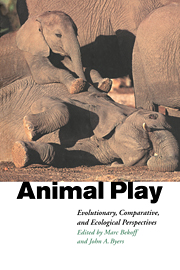Crossref Citations
This Book has been
cited by the following publications. This list is generated based on data provided by Crossref.
Pellis, Sergio M.
and
Iwaniuk, Andrew N.
1999.
The Problem of Adult Play Fighting: A Comparative Analysis of Play and Courtship in Primates.
Ethology,
Vol. 105,
Issue. 9,
p.
783.
Trevarthen, Colwyn
1999.
Musicality and the intrinsic motive pulse: evidence from human psychobiology and infant communication.
Musicae Scientiae,
Vol. 3,
Issue. 1_suppl,
p.
155.
Pellis, Sergio M.
and
Iwaniuk, Andrew N.
2000.
Comparative analyses of the role of postnatal development on the expression of play fighting.
Developmental Psychobiology,
Vol. 36,
Issue. 2,
p.
136.
Pellis, Sergio M.
and
Iwaniuk, Andrew N.
2000.
Adult–Adult Play in Primates: Comparative Analyses of its Origin, Distribution and Evolution.
Ethology,
Vol. 106,
Issue. 12,
p.
1083.
Bryson, J.
and
Thórisson, K. R.
2000.
Dragons, bats and evil knights: A three-layer design approach to character-based creative play.
Virtual Reality,
Vol. 5,
Issue. 2,
p.
57.
Pellis, Sergio M.
Pasztor, Tamara J.
Pellis, Vivien C.
and
Dewsbury, Donald A.
2000.
The organization of play fighting in the grasshopper mouse (Onychomys leucogaster): Mixing predatory and sociosexual targets and tactics.
Aggressive Behavior,
Vol. 26,
Issue. 4,
p.
319.
Burghardt, Gordon M.
2001.
Developmental Psychobiology.
Vol. 13,
Issue. ,
p.
317.
Iwaniuk, Andrew N.
Nelson, John E.
and
Pellis, Sergio M.
2001.
Do big-brained animals play more? Comparative analyses of play and relative brain size in mammals..
Journal of Comparative Psychology,
Vol. 115,
Issue. 1,
p.
29.
Irvine, Leslie
2001.
The Power of Play.
Anthrozoös,
Vol. 14,
Issue. 3,
p.
151.
Holmes, Warren G.
2001.
Developmental Psychobiology.
Vol. 13,
Issue. ,
p.
281.
Pasztor, Tamara J.
Smith, Lori K.
MacDonald, Neala K.
Michener, Gail R.
and
Pellis, Sergio M.
2001.
Sexual and aggressive play fighting of sibling Richardson’s ground squirrels.
Aggressive Behavior,
Vol. 27,
Issue. 4,
p.
323.
McDonnell, Sue M
and
Poulin, Amy
2002.
Equid play ethogram.
Applied Animal Behaviour Science,
Vol. 78,
Issue. 2-4,
p.
263.
Arnold, Jennifer L.
and
Siviy, Stephen M.
2002.
Effects of neonatal handling and maternal separation on rough‐and‐tumble play in the rat.
Developmental Psychobiology,
Vol. 41,
Issue. 3,
p.
205.
Kipper, Silke
and
Todt, Dietmar
2002.
The use of vocal signals in the social play of barbary macaques.
Primates,
Vol. 43,
Issue. 1,
p.
3.
Wolch, Jennifer
2002.
Anima urbis.
Progress in Human Geography,
Vol. 26,
Issue. 6,
p.
721.
Donaldson, Tammy M
Newberry, Ruth C
Špinka, Marek
and
Cloutier, Sylvie
2002.
Effects of early play experience on play behaviour of piglets after weaning.
Applied Animal Behaviour Science,
Vol. 79,
Issue. 3,
p.
221.
Keil, Charles
2002.
They Want the Music but They Don't Want the People.
City & Society,
Vol. 14,
Issue. 1,
p.
37.
De Oliveira, Cláudia R.
Ruiz‐Miranda, Carlos R.
Kleiman, Devra G.
and
Beck, Benjamin B.
2003.
Play Behavior in Juvenile Golden Lion Tamarins (Callitrichidae: Primates): Organization in Relation to Costs.
Ethology,
Vol. 109,
Issue. 7,
p.
593.
Bock, John
2004.
Introduction: New evolutionary perspectives on play.
Human Nature,
Vol. 15,
Issue. 1,
p.
1.
Schuster, Richard
and
Perelberg, Amir
2004.
Why cooperate?.
Behavioural Processes,
Vol. 66,
Issue. 3,
p.
261.



